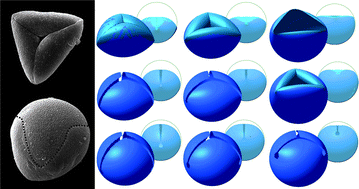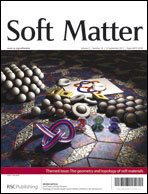Folding of an opened spherical shell†
Abstract
Thin, doubly curved shells occur commonly in nature and their mechanical properties and modes of deformation are very important for engineering structures of all scales. Although there has been substantial work on the stability and modes of failure of thin shells, relatively little work has been done to understand the conditions that promote continuous large scale deformations. A major impediment to progress in this direction is the inherent difficulty in obtaining analytical expressions for the deformed shapes. In this work we propose a new integrable solution which describes the behavior under load of a thin spherical shell with an opening (aperture) of n-fold axial symmetry. We derive a two-parameter family of approximately isometric, constant positive Gaussian curvature shapes that is in excellent agreement with our experimental results of deformed shells (3D scans of compressed ping-pong balls) and simulations (tethered membrane simulations minimizing the stretching and bending energy). The integrable solutions that describe those shapes have n symmetrically arranged curvature singularities which correspond to cusps of the folded shape. We examine the properties of the folded shells and observe that in the analytic solutions isometric closure is more easily achieved when the singularities lie away from the center of the aperture. We find that when allowed by the geometry of the aperture and the nature of the load, physical shells expel the curvature singularities into the aperture.

- This article is part of the themed collection: The geometry and topology of soft materials

 Please wait while we load your content...
Please wait while we load your content...